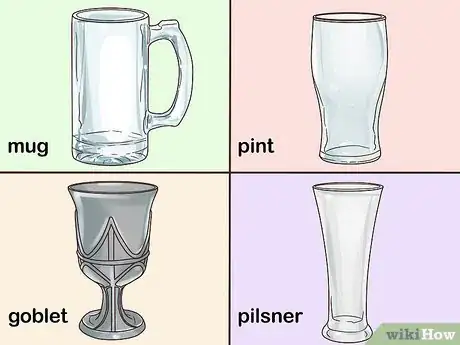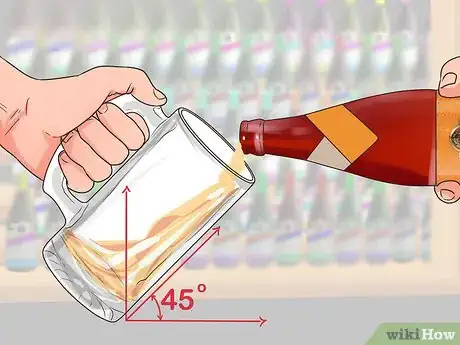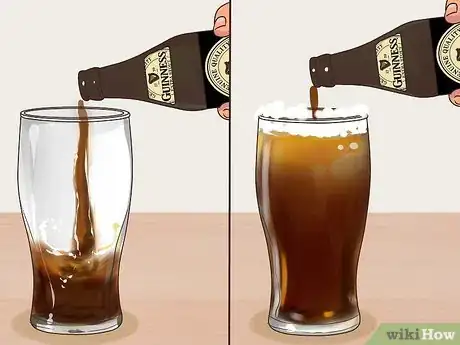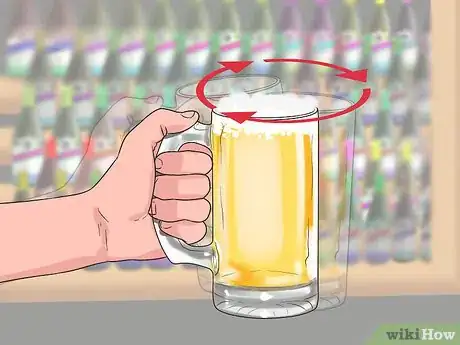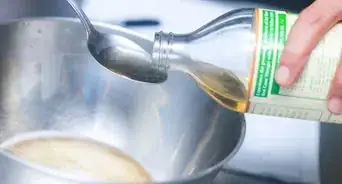This article was co-authored by Bryan Sullivan. Bryan Sullivan is a Bartender and the Owner of Bryan Sullivan Bartending in Seattle, Washington. With over 10 years of experience, he specializes in craft cocktails and has a thorough knowledge of beer, wine, and champagne. He currently holds a MAST Class 12 Mixologist Permit and has provided bar service for 100s of events. Additionally, his business has a 5-star rating and is a listed vendor on The Knot.
This article has been viewed 378,624 times.
There are many common misconceptions as to how beer should be stored, poured and enjoyed. We'll start out with how to find the right beer, the right glass, and the right food pairing. Then we'll get into pouring, storing, and enjoying. Beer 101? Check.
Steps
Getting the Best Taste
-
1Choose the right beer. Gone are the days when you thought beer only came out of a keg and into a red plastic cup. There are an infinite amount of varieties out there, meaning there's a beer out there that matches your ideal taste. Here's a brief and not-at-all comprehensive rundown (that would take ages):[1]
- Ales. These ferment quickly and are generally a bit sweeter, fuller-bodied, and have a fruity flavor. Indian Pale Ales (IPAs) have more hops and are generally bitter. This category includes pale ales, wheat beers, bitters, porters, stouts, barley wines, brown ales and tripels. Watch out for tripels – they've been fermented several times and can knock you off your feet.
- Lagers. These ferment slowly and tend to have a "crisper" flavor than ales and are, in general, less "hoppy." Think of Heineken, Bud Light, Natural Light, Harp, Corona, Miller Genuine Draft – these are all light lagers.[2] This category also includes pilsners, Vienna lagers, bocks and martens.
- Stouts. These really fall under the "ale" umbrella, but they are their own beast. A stout is dark and often creamy, with tastes of chocolate and coffee undertones. There are also oatmeal and oyster stouts, too. For these, think Guinness, Beamish, and Samuel Smith Oatmeal Stouts.
- Bitters. These are English ales that have a deep bronze look and a well-hopped flavor (in other words, bitter). In general, they have greater depth than IPAs. It's hard to qualify their taste beyond that as there are several categories: session or ordinary bitter, best or regular bitter, and premium or strong bitter (often called Extra Special Bitters (ESB)).
- Wheat Beer (or Hefeweizen). This is an ale with a light yet hazy appearance. It often has a slight banana or clove flavor. Sometimes it's spicy or apple-y, too. It's not bitter and it's often served with a wedge of lemon.
-
2Choose the right glass for the right beer. Just like red wines and white wines (and hard liquors) need to be treated differently and put it in different glasses, the same goes for different varieties of beer. Here's a few things to consider:[3]
- Mugs – good for IPAs, red, black, brown, and blonde American Ales, Pilsner, English Stouts, smoked beer, witbier, American and English Porters
- Pint glasses – good for American Ales, IPAs, Pale Ales, English Bitter and mild English Ales, cream ales, dark Lager, and Stouts.
- Goblets: Belgian IPAs and strong, dark ales, quadruples, and tripels
- Pilsner glasses: Vienna and Japanese lagers, Euro dark and strong lagers, American malt liquors, pale and red lagers, doppelbocks
- Weizen glasses: Dark and pale wheat ales, and all "weizens"
Advertisement -
3Choose the right beer to complement your meal. Beer pairs just as well – if not better – with food like wine. And in general, it's the same idea: lighter foods like salads and fish go with lighter beers. Heavier foods and meatier meats go with darker beers. You should also pair "regional" beers with the food of that region. Apart from that, here are a few things to remember:[4]
- Does your beer have a caramel, cocoa, or coffee flavor? Pair it with a smokey flavor, like with char-grilled foods.
- Is your beer hoppy? This can provide an herbal contract to fattier foods, like salmon, pizza, and fried foods.
- Is your beer sweet and fruity? Think appetizer plates, like grapes, cheeses, and bruschetta.
Pouring Your Beer Correctly
-
1Choose a beer that's been stored properly in a cool, dark location. It's important to store your beer in a cool area, away from direct light, heat and in a constant temperature. Ideally, most beers should be kept around 50–55 °F (10–13 °C). Anything higher and the lifespan of your beer will be shortened; anything lower and you'll make it hazy or cloudy.
- Wanna get technical? Strong beers (like barleywines, tripels, and dark ales) will be best enjoyed when kept just below room temperature, around 55-60F. Standard ales (like bitters, IPAs, doppelbocks, lambics, stouts, etc) should be at "cellar temperature, 50-55F. Lighter beers (think lagers, pilsners, wheat beers, milds, etc) should be around refrigerated temperature, or 45-50F.[5]
- Think of it this way: the higher the alcohol content, the higher the temperature required, and vice versa.
-
2Grab a clean class. A dirty glass may contain oils or grime that interferes with the true flavor of your beer. Also, it's just a little gross. To be sure, run your glass under hot water; use soap and water if necessary. Hold it up to the light to inspect for smudges and oil.
- Don't mix your glasses, either. If it's a beer glass, use it as just a beer glass. Try putting beer in a milk glass and you'll get the picture.
- It helps to chill the glass ahead of time.
-
3Pour the beer in at a 45-degree angle. For the perfect beer, you need about 1" to 1-1/2" of "head" (the foamy stuff), or about 2.5–3 centimeter (1.0–1.2 in).[6] To get at this, start by pouring the beer into your perfect glass at a 45-degree angle. The beer should stream down the midpoint of the side of the glass, allowing it to aerate. This creates the "head".
- Having a head is very important to get to the true flavors of the beer. No head and you'll lose what makes your beer tasty and delicious. It'll also provide a stronger, more decadent aroma.
- You can also tilt the glass to the side at an angle when pouring the beer in.
-
4Level the glass and start to pour straight in. When the glass becomes half full, start leveling it out slowly, pouring straight into the glass. This minimizes the head created, giving you the perfect amount.
- If your head is forming too quickly (this happens with some beers), start pouring straight down the middle sooner. If it's not forming, keep it at an angle.
-
5Alternatively, try the double-pour method. Some people believe in the double-pour method as it supposedly increases the aroma and releases the flavors. This is especially true with Guinness (if that's how they do it in Dublin, it's best to follow suit). Here's how it's done:
- Pour the glass half full, accumulating a large head
- Let the head dissipate slightly
- Pour again, aiming for that 1" to 1-1/2" of the head in total
Tasting Your Beer the Right Way
-
1Look at your beer. Want to analyze your beer and learn which ones you love, which ones you loathe, and why? Start by looking at your beer, marveling at its color and body. Raise it in front of you, but not to the light (that'll make it appear lighter than it is). What do you notice?
- Think about the head. Is it foamy? Creamy? Quick to disappear?
- Consider its color. Is it more golden, red, or chestnut?
- Look at its consistency. Is it creamy? Thick or thin? Hazy with debris or clean as a whistle?
-
2Swirl your beer a bit. Just like you swirl around a glass of good red wine, swirl around your beer. This releases the aromas and fragrances of your particular beer. It pulls out the nuances and tests its head retention.
- How does this beer differ from other beers you're used to when you swirl it around? How does the carbonation loosen? What happens from the bottom to the top of the beer?
-
3Smell it. Most the taste is smell, after all. Take the first whiff through your nose. What do you sense? Fruits? Bread? Chocolate? Then take a whiff through your mouth (yes, the two are connected). Does it change at all?
- If need be, swirl it around again. Does this intensify the smell?
-
4Go in for the taste. Take your first sip. Don't swallow quite yet. Let it ruminate on your palate, wandering and exploring every taste bud. How does it feel in your mouth? Now breathe out (this could change the taste as mucus gets released). Detect even the smallest flavors, like salty or sweetness. How does it change as it warms in your mouth, too?
- Then swallow. Then repeat. Repeat, repeat, repeat, and repeat. How is it changing with every sip? Does it change as you reach the bottom of your glass?
-
5Drink up! Don't leave it to get warm and stale. If you drank from a bottle (why would you do that?) and you recap it for later, it'll get skunky when you come back to it, so don't bother. Beer is best now.
- Okay, so you can let it get a little warm. Really, really cold beer has its flavors masked by temperature. Let it warm up a bit and you may notice nice changes. But there's a line where it crosses and becomes not so tasty – if you wait, you'll find that line.
Community Q&A
-
QuestionDoes warming beer up on a gas column spoil it?
 Community AnswerYes, you should not warm it up and especially should not boil it. It should be drank cold or at room temp if you have to.
Community AnswerYes, you should not warm it up and especially should not boil it. It should be drank cold or at room temp if you have to. -
QuestionWhat can I add to it as mixer?
 Community AnswerLighter-colored beers (not stout, brown ale, porter, or bitters) can be mixed with lemonade to create a radler or shandy. There are also beer cocktails, the most famous of which is the black velvet, which is Guinness (or alternatively, a good stout) mixed with champagne.
Community AnswerLighter-colored beers (not stout, brown ale, porter, or bitters) can be mixed with lemonade to create a radler or shandy. There are also beer cocktails, the most famous of which is the black velvet, which is Guinness (or alternatively, a good stout) mixed with champagne.
Expert Interview
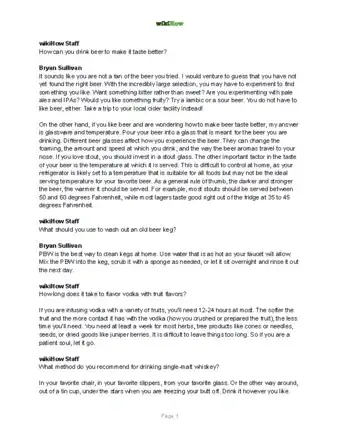
Thanks for reading our article! If you'd like to learn more about drinking beer, check out our in-depth interview with Bryan Sullivan.
References
- ↑ http://www.primermagazine.com/2009/learn/a-guide-to-understanding-beer-and-how-to-find-new-favorites
- ↑ https://www.ratebeer.com/feature/apr-14-2005-the-10-minute-beer-expert/457/
- ↑ http://www.beeradvocate.com/beer/101/glassware/
- ↑ https://www.ratebeer.com/feature/apr-14-2005-the-10-minute-beer-expert/457/
- ↑ http://www.beeradvocate.com/beer/101/store/
- ↑ http://www.beeradvocate.com/beer/101/pour/
About This Article
To drink beer, start by picking the right glass for the beer you’re drinking. For example, choose a mug for Indian Pale Ales or a pint glass for American ales. Then, pour the beer into your glass at a 45°angle to create the perfect “head,” or foam. Next, swirl the beer in your glass to release the beer’s aromas, then take a whiff through your nose and see what flavors you can sense. Finally, take your first sip, hold it in your mouth to get the full flavor, and swallow it. To learn more, including how to choose the right beer to complement your meal, read on!

